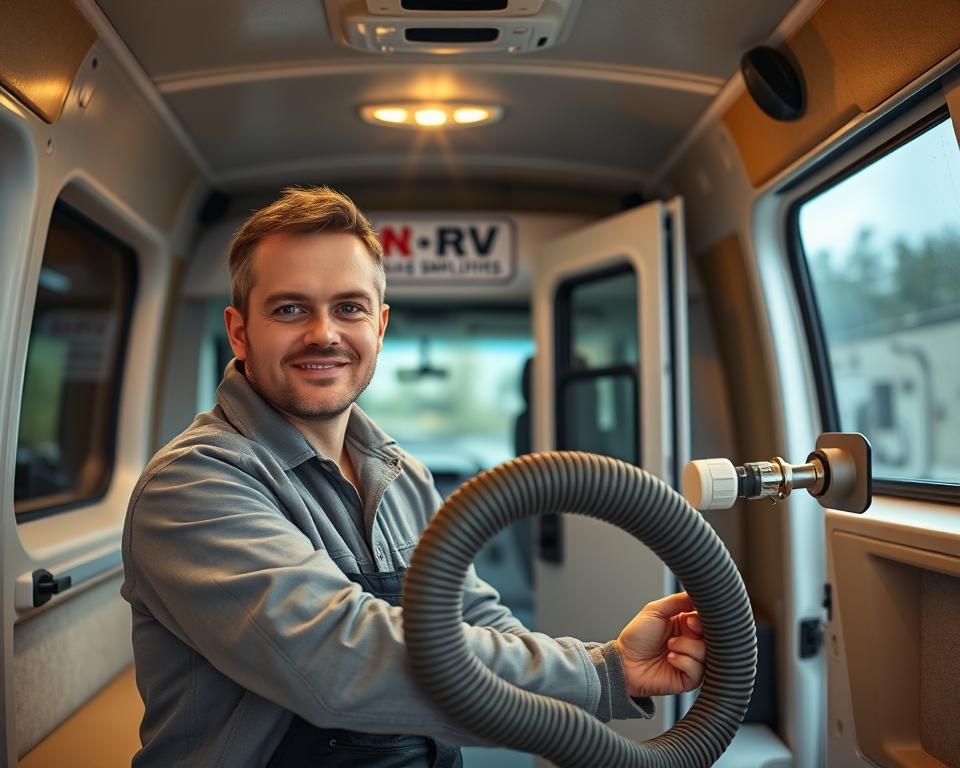Camper Septic Pumping Guide: Essential Tips
Have you ever wondered what unfolds if you overlook your RV’s septic system? Visualize the horror of waking up to a foul smell and a failing sewage unit while camping. Routine camper septic pumping and waste management are critical to a hassle-free journey. Our guide details RV sewage disposal, motorhome waste removal, and cassette toilet tips. Once you understand how to handle your RV’s septic system, you’ll avoid problems and completely enjoy your excursions.
Notable Observations
- Familiarizing yourself with your RV septic infrastructure is vital for effective maintenance.
- Routine camper septic pumping ward off costly repairs.
- Understand the recommended practices for RV sewage disposal.
- Leverage professional services like All in Sanitation for effective waste management.
- Head off odors and clogs with regular checks and maintenance.
RV Septic System Basics
Learning how your RV septic system works is critical to managing waste efficiently – RV black water pump. The arrangement contains three main tanks: the black tank for toilet waste, the gray tank for sink and shower water, and the freshwater tank. Drain pipes, two-inch for sinks and 3-inch for toilets, allow waste movement. Recognizing these elements is vital for timely upkeep and prompt waste removal.
The primary waste tank is essential for sewage management in an RV. It demands scheduled emptying to prevent overfills and foul smells. Using a recreational vehicle septic service for this task can boost your system’s lifespan. The gray tank also warrants attention to avoid clogs from stagnant water.
Comprehending the inner workings of your RV septic system enables you to maintain it better. Routine checks and cleanings not only lengthen your RV’s life but also mitigate health hazards from septic failures.
The Value of Regular Camper Septic Pumping
Consistent camper septic pumping is vital for your RV’s waste management system. Ignoring pumping needs can trigger clogs and backups. These issues not only affect your system but also jeopardize the environment by contaminating local ecosystems.
Employing professional sanitation services ensures safe waste disposal. Companies like All in Sanitation provide dependable camper septic pumping. This supports your system and safeguards the environment. A properly cared-for septic system means a cleaner, safer environment for campers and nature lovers.
To conclude, keeping up with septic pumping avoids expensive repairs and delivers a better camping experience. Proactive waste management protects personal health and the earth, emphasizing its importance for RV owners.
Optimal Pumping Schedule for RV Septic
The frequency you must pump your RV’s septic tank heavily affects its performance. It varies with occupancy and the volume of the tank. It is generally wise to empty the black tank every 3-5 days. If you wait too long, waste can harden, making it harder to clean out.
Monitoring tank levels is key for maintaining your RV’s waste system. Aim to dump the waste when the reservoir is about two-thirds full. Overfilling can trigger spills, foul smells, and pricey damage. Routine maintenance and quick attention to the waste levels ensure a trouble-free journey.
Emptying RV Tanks: Best Practices
Properly emptying your RV reservoirs wards off undesirable scenarios. Always start by draining the black tank, followed by the gray reservoir. This method ensures minimal contact with waste, improving hygiene.
It’s key to use a leak-proof sewer hose. A reliable hose avoids spills and enhances safety during waste disposal. After emptying, carefully flushing the primary waste tank is vital.
For a complete clean, apply a built-in black tank flush or a reservoir rinser. These tools effectively dislodge residues, guaranteeing the reservoir is properly sanitized.
Finding the right disposal sites is essential for responsible waste management. Ideally, use designated dump stations for RV black water disposal. Companies like All in Sanitation also offer mobile pump-out services, bringing convenience for RV users.
The Right Way to Dump Waste
Dumping waste from your RV is an unavoidable task that requires proper attention to guarantee a smooth process. Begin by emptying the black tank, which holds solid waste. Once the primary tank is emptied, move on to the gray reservoir. This method efficiently rinses the sewage hose, minimizing residue and odor.
Ahead of attaching the cassette toilet hose, completely check your waste hose’s connections to prevent leaks. A reliable attachment secures your equipment and maintains a clean environment for camper holding tank pumping. Upon completion of dumping, ensure the valves are securely closed before disconnecting any hoses.
Dumping can be done either at specialized dump stations or at sites with full hookup facilities. Both methods call for following right procedures to maintain hygiene and efficiency in RV waste management.
How to Stop Odors and Clogs
To avoid unpleasant smells, RV septic systems call for proper upkeep. Owners should keep their tanks adequately filled with water. Choosing RV-safe toilet paper is key to preventing blockages. It helps in the appropriate breakdown of waste. Frequently adding enzyme-based treatments considerably boosts waste management.

Reviewing the vent pipe regularly is key to prevent clogs and interior odors. Implementing routine cleaning practices, like systematic flushing, can maintain the camping atmosphere fresh and inviting. This delivers a pleasant experience for all RV campers.
Typical Errors in RV Septic Management
Many RV owners unknowingly make errors with their septic systems. Understanding these mistakes elevates RV waste water disposal. A common error is flushing items that don’t break down easily, causing significant clogs and blocking the system’s function.
Permitting solids build up due to skipping flushes is another issue. Infrequent maintenance leads to buildup, demanding pricey repairs. Remember, regular attention saves both time and resources.
The following list details common items that should not be flushed:
- Wipes
- Feminine hygiene products
- Certain types of toilet paper
Skipping these errors and adopting safer RV septic management permits travelers enjoy their journeys without facing unnecessary septic difficulties.
| Mistake | Consequences | Prevention |
|---|---|---|
| Flushing Non-biodegradable Items | Clogs and blockages | Use only biodegradable toilet paper and proper disposal methods |
| Infrequent Tank Flushing | Solid accumulation and odors | Schedule regular flushing and maintenance |
| Ignoring Manufacturer Recommendations | System inefficiencies | Follow guidelines provided in the RV manual |
Professional Pump-Out: When and Why
Understanding when to book mobile home septic pumping is important. It avoids major problems later. Clues like slow drains, unexplained smells, or visible waste hint a professional might be needed.
Prolonged stays or heavy use of your RV produce more waste than usual. A professional service like All in Sanitation can solve these issues. They guarantee your reservoir is properly cleaned, heading off clogs. Scheduled maintenance stops future hassles, upgrading your RV experience.
Long-Term RV Septic Care
Scheduled maintenance is critical to lengthening the life of your RV septic system. A robust RV septic service routine ensures long-lasting function and top performance. This includes not just the deep cleaning of tanks but also checking seals and cleaning the system thoroughly to avoid problems.
Integrating these practices into your camping habits assists in managing residue buildup, improving waste disposal. Here’s what you should periodically do:
- Clean reservoirs thoroughly every few months.
- Inspect seals for wear and tear to prevent leaks.
- Sanitize the system to get rid of bacteria and odor.
- Check hoses and connections for damage.
Executing these steps ahead of time helps RV owners sidestep costly repairs later, securing a smooth camping journey. Proper septic system maintenance improves your outdoor adventures, making them more enjoyable.
Promoting Waste Management Awareness
Guiding RVers proper waste management is essential for a sustainable environment at campgrounds. Highlighting the right habits can avoid issues like clogs and foul odors.
To raise awareness, placing informative educational signs is central. Such signs should clearly state what can and cannot be thrown into sewer systems, reducing errors.
To further educate, campground owners might offer workshops on sanitation. These give hands-on demonstrations on correct waste management. Handing out brochures and flyers also helps stress the need for responsible disposal. Knowing the correct procedures improves the camping experience for everyone.
Final Thoughts
Effective camper septic pumping and diligent RV sewage disposal are key for a better outdoor experience. Steady maintenance and learning how your septic system operates make all the difference. They guarantee a camping trip without hassles. Applying best practices helps sidestep issues like clogs and bad smells, enhancing your enjoyment of nature.
Collaborating with trustworthy services such as All in Sanitation gives expert assistance when you need it. It secures your RV’s septic system working well and preserves the environment. Teaching other RVers about important sanitation practices creates a community that respects cleanliness and the health of our ecosystem. This forms a pathway for adventures that are both rewarding and environmentally responsible.
Being knowledgeable about camper septic pumping and employing correct RV sewage disposal techniques allows you connect with nature without neglecting cleanliness. We need to promote awareness and responsibility within the RV community. Collectively, we can make our outdoor spaces cleaner and more inviting for all.

